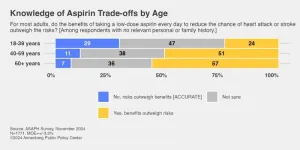(Press-News.org) New York, NY, February 3, 2025 — The Vilcek Foundation has announced $250,000 in awards recognizing immigrant scientists. The 2025 Vilcek Foundation Prizes in Biomedical Science are bestowed as part of the foundation’s annual prizes program in support of its mission.
The Vilcek Foundation Prizes in Biomedical Science are a tribute to Vilcek Foundation co-founder Jan Vilcek, biomedical scientist and philanthropist. Born in Slovakia, Vilcek excelled as a researcher and immunologist, publishing his first single-author paper in Nature at 26. In 1965, with his wife, Marica, he immigrated to the United States to continue his career at New York University, where he would go on to pioneer the development of the life-saving drug Remicade® (Infliximab).
“Immigrant scientists bring a wealth of perspective and insight to their work in the United States, including alternative ways of viewing and approaching research questions,” says Vilcek Foundation President Rick Kinsel. “This creativity and ingenuity has led to important breakthroughs in biomedical research: from the development of noninvasive imaging techniques to reshaping our understanding of the molecular and metabolic mechanisms of disease. With the Vilcek Foundation Prizes, we celebrate immigrant scientists at the forefront of innovation, and raise awareness of the importance of immigration for scientific advancement.”
In 2025, the Vilcek Foundation awards four prizes in biomedical science: The Vilcek Prize, and three Vilcek Prizes for Creative Promise.
The Vilcek Prize: Marianne Bronner
The Vilcek Prize recognizes a biomedical research scientist whose career work represents a significant contribution to their field and to scientific research and medicine more broadly. The recipient of the Vilcek Prize receives a cash award of $100,000 and a commemorative trophy. The foundation is delighted to award the 2025 Vilcek Prize to Marianne Bronner.
Bronner is a developmental biologist at Caltech, where she is the Edward B. Lewis Professor of Biology and the director of the Beckman Institute. She receives the Vilcek Prize in Biomedical Science for her career research on neural crest stem cells and their role in the development of the peripheral nervous system, heart, and craniofacial skeleton in vertebrate organisms. A member of the National Academy of Sciences, Bronner is an advocate for gender equity in science. Born in Hungary, Bronner emigrated to the United States with her family as a young child.
The Vilcek Prizes for Creative Promise
The Vilcek Prizes for Creative Promise are awarded to early- and mid-career biomedical scientists whose work has had a significant impact on their field of study. Using interdisciplinary approaches, these scientists are advancing biomedical research in ways that have profound implications for our ability to understand, diagnose, and treat disease. Creative Promise Prizewinners each receive a commemorative trophy and an unrestricted cash award of $50,000.
The Vilcek Foundation is proud to announce that Elham Azizi, Guosong Hong, and Maayan Levy are the recipients of the 2025 Vilcek Prizes for Creative Promise in Biomedical Science.
Azizi receives the Vilcek Prize for Creative Promise in Biomedical Science for her research engaging machine learning, statistics, genomics, and bioengineering to derive principles of cancer initiation, progression, and response to immunotherapies in cancer patients. Born in Iran, Azizi is an alumna of Sharif University of Technology and of Boston University, where she earned her MS and PhD. She is an associate professor of cancer data research and biomedical engineering at Columbia University.
Hong receives the Vilcek Prize for Creative Promise in Biomedical Science for the development of novel neuroengineering tools combining materials science and biology that engage ultrasound, light, and radio-frequency-based interfaces to study the brain. Born in China, Hong is an alumnus of Peking University; he earned his PhD in Chemistry from Stanford University, where he is now an assistant professor of materials science and engineering.
Levy receives the Vilcek Prize for Creative Promise in Biomedical Science for her immunological research studying the potential therapeutic applications of metabolites as vehicles and targets to prevent and treat diseases, including cancer. Born in Israel, Levy earned her BSc at Tel Aviv University and holds a PhD from the Weizmann Institute of Science. Levy recently joined the Stanford University School of Medicine as an assistant professor of pathology.
The 2025 Vilcek Foundation Prizes
The Vilcek Foundation Prizes in Biomedical Science are awarded as part of the 2025 Vilcek Foundation Prizes Program. In 2025 the foundation awards a total of $950,000 in prizes to immigrant professionals in the sciences and humanities, and to intellectual and cultural leaders with the Vilcek Foundation Prizes in Biomedical Science, Visual Arts, and Curatorial Work, the Vilcek Prize for Excellence, and the Marica Vilcek Prize in Art History.
The Vilcek Foundation
The Vilcek Foundation raises awareness of immigrant contributions in the United States and fosters appreciation for the arts and sciences. The foundation was established in 2000 by Jan and Marica Vilcek, immigrants from the former Czechoslovakia. The foundation's mission was inspired by the couple’s respective careers in biomedical science and art history. Since 2000, the foundation has awarded over $15 million in prizes and grants.
The Vilcek Foundation is a private operating foundation, a federally tax-exempt nonprofit organization under IRS Section 501(c)(3). To learn more, please visit vilcek.org.
END
Vilcek Foundation celebrates immigrant scientists with $250,000 in prizes
2025-02-03
ELSE PRESS RELEASES FROM THIS DATE:
Age and sex differences in efficacy of treatments for type 2 diabetes
2025-02-03
About The Study: This systematic review and network meta-analysis of 601 eligible trials found that sodium-glucose cotransporter 2 (SGLT2) inhibitors and glucagon-like peptide-1 (GLP-1 receptor agonists were associated with lower risk of major adverse cardiovascular events. Analysis of age × treatment interactions suggested that SGLT2 inhibitors were more cardioprotective in older than in younger people despite smaller reductions in hemoglobin A1c; GLP-1 receptor agonists were more cardioprotective in younger people.
Corresponding Author: To contact the corresponding author, Peter Hanlon, PhD, email peter.hanlon@glasgow.ac.uk.
To access the ...
Octopuses have some of the oldest known sex chromosomes
2025-02-03
The octopus just revealed another one of its secrets: what determines its sex.
University of Oregon researchers have identified a sex chromosome in the California two-spot octopus. This chromosome has likely been around for 480 million years, since before octopuses split apart from the nautilus on the evolutionary tree. That makes it one of the oldest known animal sex chromosomes.
The finding also is evidence that octopuses and other cephalopods, a class of sea animals that includes squid and nautiluses, do use chromosomes to determine their sex, answering a longstanding mystery among biologists.
“Cephalopods are already such interesting creatures, ...
High-yield rice breed emits up to 70% less methane
2025-02-03
Rice cultivation is responsible for around 12% of global methane emissions, and these emissions are expected to increase with global warming and as the human population continues to grow. Now, scientists have identified chemical compounds released by rice roots that determine how much methane the plants emit. On February 3 in the Cell Press journal Molecular Plant, they report that this information enabled them to breed a new strain of rice that emits up to 70% less methane.
“This study shows that you can have low methane and ...
Long COVID prevalence and associated activity limitation in US children
2025-02-03
About The Study: In 2023, post–COVID condition (PCC) continued to affect U.S. children at similar levels as 2022 and to have similar sociodemographic patterns. The large proportion of children experiencing PCC with any activity limitation highlights the need to examine the severity of activity limitation, functional outcomes, and days lost from school.
Corresponding Author: To contact the corresponding author, Nicole D. Ford, PhD, MPH, email yex9@cdc.gov.
To access the embargoed study: Visit our For The Media website ...
Intersection of race and rurality with health care–associated infections and subsequent outcomes
2025-02-03
About The Study: This cohort study of hospitalized adults identified inequities related to race and rurality in health care–associated infections (HAIs) and adverse outcomes from HAIs. These findings suggest that factors such as structural racism and disinvestment in rural communities may be associated with individual HAI risk and post-HAI outcomes. Future work to further understand the reasons underpinning these disparities and methods to address structural factors through policy and process changes are critical to ...
Risk of attempted and completed suicide in persons diagnosed with headache
2025-02-03
About The Study: The results of this cohort study revealing the robust and persistent association of headache diagnoses with attempted and completed suicide suggest that behavioral health evaluation and treatment may be important for these patients.
Corresponding Author: To contact the corresponding author, Holly Elser, MD, PhD, email holly.elser@pennmedicine.upenn.edu.
To access the embargoed study: Visit our For The Media website at this link https://media.jamanetwork.com/
(doi:10.1001/jamaneurol.2024.4974)
Editor’s Note: Please see the article for ...
Adolescent smartphone use during school hours
2025-02-03
About The Study: Using passive sensing on a sample of U.S. adolescents, this study found half of adolescents use their smartphones during school for at least 66 minutes daily, primarily using messaging and social media. These findings extend a prior study limited to Android devices that found adolescents spent a median of 43 minutes on their phones during school.
Corresponding Author: To contact the corresponding author, Lauren Hale, PhD, email Lauren.Hale@stonybrookmedicine.edu.
To ...
Alarming rise in rates of advanced prostate cancer in California
2025-02-03
Alarming Rise in Rates of Advanced Prostate Cancer in California
Following a change in screening guidelines, the incidence went up across the state, even more than it has nationally.
The incidence of advanced prostate cancer in California rose markedly in the decade since doctors stopped routinely screening all men for the disease, according to a new study by UC San Francisco.
After declining for many years, the death rate from the disease also plateaued in most regions across the state.
The findings reinforce the need for screening that can identify potentially fatal tumors without raising false alarms about ones that pose no threat to the patient.
The ...
Nearly half of adults mistakenly think benefits of daily aspirin outweigh risks
2025-02-03
For years, healthy older adults were advised by doctors to take a low-dose aspirin daily as a way to reduce the risk of heart attack. But in March 2019, the American College of Cardiology and the American Heart Association (AHA) announced new guidelines and no longer routinely recommended a daily dose of aspirin for healthy adults over the age of 70 because the risk of gastrointestinal bleeding outweighs the benefits.
Nearly five years later, many Americans still have not received the message.
The Annenberg Public Policy Center (APPC) of the University of Pennsylvania finds in a new health survey that nearly half (48%) of U.S. ...
Cardiovascular disease medications underused globally
2025-02-03
Secondary prevention medications for cardiovascular diseases (CVD) are underused globally and additional strategies to increase their use are needed to improve CVD management and reduce premature mortality rates, according to study published today in JACC, the flagship journal of the American College of Cardiology. The study observed participants with CVD from 17 countries over 12 years and found that medication use remains low with little improvement.
Secondary prevention of CVD focuses on preventing further health problems in people already diagnosed with CVD. This includes managing risk factors through lifestyle changes, medications and ...


